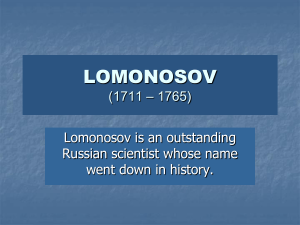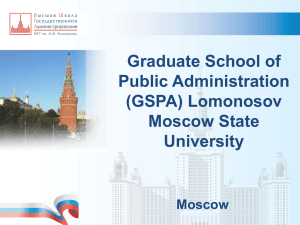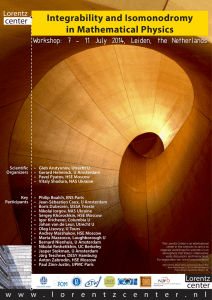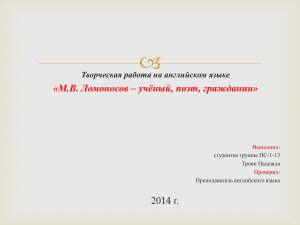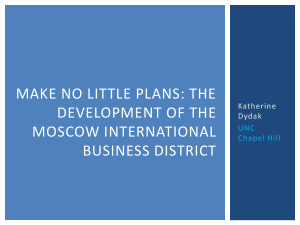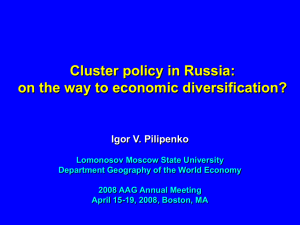Слайд 1 - PCAM - Physics and Chemistry of Advanced Materials
advertisement
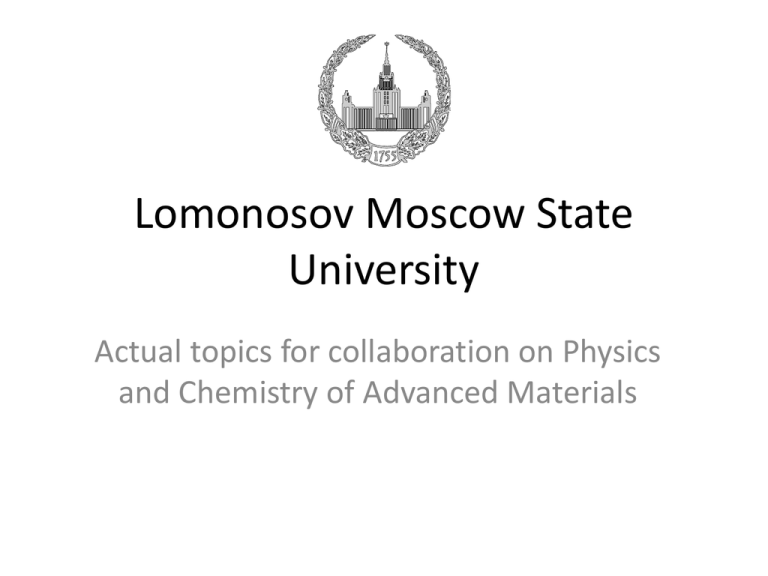
Lomonosov Moscow State University Actual topics for collaboration on Physics and Chemistry of Advanced Materials Topics: Advanced carbon materials for modern applications Professor A. Obraztsov, Physics Department Materials for energy storage and conversion Professor E. Antipov, Chemistry Department Organic photovoltaics Professor D.Paraschuk, Physics Department New technology of HT-supercondactors production Professor A. Kaul, Chemistry Department Novel thermoelectric materials Professor A.Shevelkov, Chemistry Department Others topics could be considered as well! Lomonosov Moscow State University Actual topics for PCAM collaboration Carbon nanotube forest production by CVD cathode plasma Metal plate with holes substrate anode Remote plasma allows usage non-conductive (dielectric) materials for substrate and reduce substrate temperature. Lomonosov Moscow State University Actual topics for PCAM collaboration [R.R. Ismagilov et al., Nano ACS, submitted] Non-catalytical production of carbon nanotubes Traditional catalytical CNT growth “Catalyst free” growth of CNT Lomonosov Moscow State University Actual topics for PCAM collaboration [R.R. Ismagilov et al., Nano ACS, submitted] Mesoporous Nano-Graphite Films A.N. Obraztsov et al., Diamond and Rel. Mat. 8(199)814 Carbon 46(2008)963 Lomonosov Moscow State University Actual topics for PCAM collaboration Graphite films of nanometer thickness AFM image of graphite film on Ni STM image of graphite film on Ni Graphite CVD films on Ni contain atomically flat regions and net of wrinkles. Typical height of the wrinkles is about 30 nm. Lomonosov Moscow State University Actual topics for PCAM collaboration [A.N. Obraztsov et al., Carbon 45(2007)2017] Field Effect Transistor of CVD Graphite Film FET device made with graphene flakes pilled out from CVD graphite film. 19 2 2 m o b ( h o le ) = 2 8 3 0 c m /V * s e c 2 m o b ( e le ct r o n ) = 2 1 8 0 c m /V * s e c 6 p ro b e s h o le 1 ,0 x 1 0 3,5*10 e le ct r o n 2 , 7 * 1 0 Conductanc e, S 1 ,5 x 1 0 -5 8 -5 -5 3 4 p ro b e s h o le 1,3*10 e le ct r o n 1 0 -5 -5 4 -5 V tg , V - 2,0 - 1,8 - 1,6 Lomonosov Moscow State University Actual topics for PCAM collaboration - 1,4 4 and 6 probe measurement at Room temperature SiO2 – bottom gate (15) Al2O3 – top gate (2) Source-drain contact (3,4,8,19): 5 nm Ti & 50 nm Au New materials for Li batteries Li batteries – the most efficient energy storage devices Design and testing of new cathode materials based on mixed transition metal compounds with polyanions: fluorophosphates and borates Motivation: 1)higher ionicity of the M-F bond (as compared to the M-O one) and “inductive effect” of the (MOn)mpolyanions with strong M-O bonds is expected to enhance the potential of the corresponding Mn/Mn+1 redox couple 2)twice larger amount of F is needed to achieve the same valence for transition metal larger free unit cell volume faster lithium migration Materials for batteries with higher energy and power densities Lomonosov Moscow State University Actual topics for PCAM collaboration Li2CoPO4F: perspective high-voltage cathode material - Li1 - Li2 - Li3 a a b c c b 2 migration pathways + 3.5% volume expansion (0.6 Li removal) in contrast to 7% volume contraction in olivine “Solid solution” behavior Upper limit of electrolyte Capacity vs. voltage: from potentiostatic step measurements between 4.2 V and variable anodic potentials. The slope of the capacity-voltage dependence 0.7 V per 1Li mole (like in LiCoO2) High potential range Cathode material for high energy and power densities batteries Lomonosov Moscow State University Actual topics for PCAM collaboration 1) Patent: “New Alkali Transition Metal Fluorophosphate” International Publication Number WO 2010/023129 A2, 2010, 2) Structural transformation of Li2CoPO4F upon Li-deintercalation / JOURNAL OF POWER SOURCES 196 (2011) 355-360 Third generation organic and hybrid photovoltaics: thin, flexible, cheap, and efficient Polymer-fullerene bulk heterojunction solar cells Electrodes Fullerene Polymer Flexible substrate Protective layer Light 100 nm Lomonosov Moscow State University Actual topics for PCAM collaboration Active area 13 mm2 Efficiency 4% @ AM1.5 Active area ~1 cm2 Efficiency ~1% @ AM1.5 Novel nanomaterials for third generation photovoltaics The goals: - towards 10% efficiency - to scale by wet roll-to-roll technology • Donor-acceptor charge-transfer complexes of conjugated polymers, highly photostable • Exohedral metallocomplexes of fullerenes for higher photovoltage • Low-bandgap polymers for higher photocurrent • For dye-sensitized solar cells: low-temperature TiO2 processing, Ru-free dyes, soft-solid electrolyte Lomonosov Moscow State University Actual topics for PCAM collaboration Second generation (2G) HTSC coated conductor architecture The technology is based on Metalorganic Chemical Vapor Deposition (MOCVD) of buffer and superconducting layers. 1. Biaxially textured metal tape obtained by cold rolling & annealing 2. Oxide buffer layer epitaxially grown on textured tape 3. Epitaxial superconducting layer of YBa2Cu3O7-δ 4. Protecting layer of normal metals ( Ag + Cu) - high deposition rate ~100 μm ~ 1 μm The realized conception of the material is based on the texture transfer from metal tape (textured substrate) to superconducting layer via the buffer layer Lomonosov Moscow State University Actual topics for PCAM collaboration - high superconducting properties of HTSC layers - easy way to introduce nanosized inclusions for increasing superconducting current in high external magnetic field - low process price compared to high vacuum deposition technologies At home synthesized volatile precursors Home made МОСVD equipment -Non-toxic -May be produced in industrial scale at moderate price Me(thd)3 Lomonosov Moscow State University Actual topics for PCAM collaboration New Ideas for Better TE Materials Modern concept: Phonon Glass, Electron Crystal (PGEC) Basic idea: Almost independent optimization of charge carrier transport and phonon transport due to the spatial separation of structural elements Phonon engineering ! New objects 1. Nanocage and nanoblock compounds 2. Nanocomposites 3. Superlattices and Nanostructures 2 Lomonosov Moscow State University Actual topics for PCAM collaboration 1 A.V. Shevelkov, Russ. Chem. Rev. 2008, 77, 1–19 A.V. Shevelkov, et al. Chem. Mater. 2008, 20, 2476–2483 A.V. Shevelkov, et al. Inorg. Chem. 2009, 48, 3720–3730 Recent Achievements in TE Engineering Nanocage inorganic clathrates Covalent framework: efficient transport of charge carriers Guest “rattling”: rejection of heat-carrying phonons High thermoelectric efficiency ZT = S2T/ (dimensionless) Prove of the concept: Extremely low thermal conductivity: lowest for narrow-gap semiconductors 1. 2. Already promising properties: ZT0.6 at 650 K for automotive applications ZT0.4 at 1100 K coupled to utmost chemical and thermal stability for solar energy conversion 3. Almost 3-time growth of ZT at 300 K with nanocomposites formation are new routes to better ZT possible? Lomonosov Moscow State University Actual topics for PCAM collaboration A.V. Shevelkov, et al. Solid State Sci. 2007, 9, 664–671 A.V. Shevelkov, et al. Chem. Eur. J. 2008, 14, 5414–5422. A.V. Shevelkov, et al. Chem. Eur. J. 2010, 16, 12582–12589 PCAM-MSU: Looking forward for fruitful collaboration!
